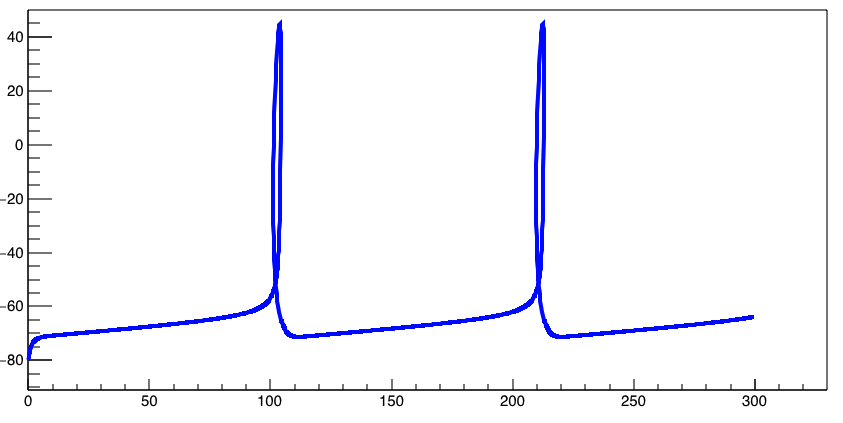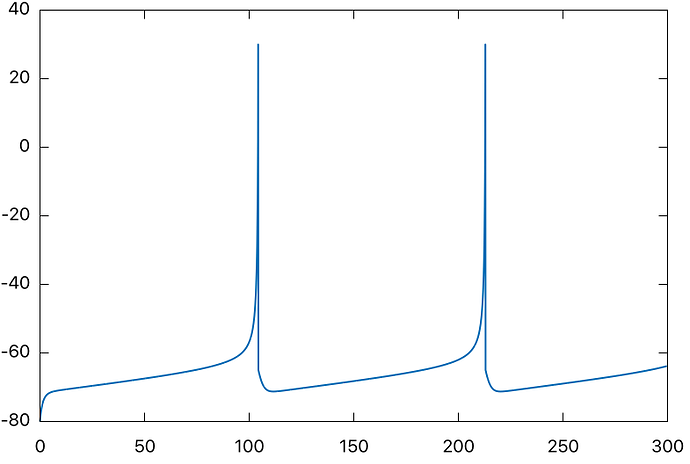Hey guys,
I’m new to ROOT (and programming). I implemented a model in C++ and would like to output the result with ROOT. The Plot looks fine when i use gnuplot, but weird if I use ROOT. It’s hard to explain, the ROOT plot somehow shows some kind of loops (which do not appear in gnuplot). I appended an image (and my Code).
#include <iostream>
#include <cmath>
#include <vector>
#include "TApplication.h"
#include "TCanvas.h"
#include "TGraph.h"
using std::cout;
using std::cin;
using std::endl;
using std::vector;
double a{0.1};
double b{0.26};
double c{-65};
double d{2};
double t_max{100};
double dt{0.1};
double v_0{-80};
double u_0{0};
double I{9.0};
struct timetrace{
vector<double> t;
vector<double> v;
vector<double> u;
float rate;
};
double dv(double v, double u, double I){
return (0.04 * pow(v, 2.0) + 5 * v + 140 - u + I);
}
double du(double v, double u){
return (a * (b * v - u));
}
timetrace V_t_trace(){
int quantity{static_cast<int>(t_max/dt)-1};
vector<double> t_array, v_array, u_array;
t_array.reserve(quantity);
v_array.reserve(quantity);
u_array.reserve(quantity);
//arrays that hold runge-kutta values:
double u1,u2,u3,u4,v1,v2,v3,v4;
timetrace trace;
t_array.push_back(0);
v_array.push_back(v_0);
u_array.push_back(u_0);
int spike_count{0};
for(int i=1; i < quantity - 1; ++i){
t_array.push_back(i * dt);
/* EULER
v_array.push_back(v_array[i-1] + dv(v_array[i-1], u_array[i-1], I) * dt);
u_array.push_back(u_array[i-1] + du(v_array[i-1], u_array[i-1]) * dt);
*/
// Runge-Kutta:
u1 = du(v_array[i-1] , u_array[i-1]) * dt;
v1 = dv(v_array[i-1] , u_array[i-1], I) * dt;
u2 = du(v_array[i-1] + v1/2.0 , u_array[i-1] + u1/2.0) * dt;
v2 = dv(v_array[i-1] + v1/2.0 , u_array[i-1] + u1/2.0, I) * dt;
u3 = du(v_array[i-1] + v2/2.0 , u_array[i-1] + u2/2.0) * dt;
v3 = dv(v_array[i-1] + v2/2.0 , u_array[i-1] + u2/2.0, I) * dt;
//TODO: Check if this is correct!
u4 = du(v_array[i-1] + v3 , u_array[i-1] + u3) * dt;
v4 = dv(v_array[i-1] + v3 , u_array[i-1] + u3, I) * dt;
u_array.push_back(u_array[i-1] + (u1+2.0*u2+u3+u4)/6.0);
v_array.push_back(v_array[i-1] + (v1+2.0*v2+v3+v4)/6.0);
// Reset condition:
if (v_array[i] >= 30){
spike_count++;
v_array[i-1] = 30;
v_array[i] = c;
u_array[i] += d;
}
}
trace.rate = spike_count/t_max * 1000;
trace.t = t_array;
trace.v = v_array;
trace.u = u_array;
return trace;
}
int main(int argc, const char * argv[]) {
//request values
cout << "a = ";
cin >> a;
cout << "b = ";
cin >> b;
cout << "c = ";
cin >> c;
cout << "d = ";
cin >> d;
cout << "Input current = ";
cin >> I;
cout << "t_max = ";
cin >> t_max;
timetrace voltage_trace = V_t_trace();
vector<double> t = voltage_trace.t;
vector<double> v = voltage_trace.v;
vector<double> u = voltage_trace.u;
float rate = voltage_trace.rate;
cout << "Firing rate is " << rate << " Hz\n";
//Plotting
TApplication* myApp = new TApplication("myApp", 0, 0) ;
TCanvas *c1 = new TCanvas("c1","Izhikevich model",200,10,1000,500);
TGraph* gr = new TGraph(v.size(),&t[0],&v[0]);
gr->SetLineColor(kBlue);
gr->SetLineWidth(4);
gr->SetMaximum(50.);
gr->Draw("AC");
c1 -> Update();
// Run the TApplication to produce all of the plots
myApp->Run() ;
return 0;
}

